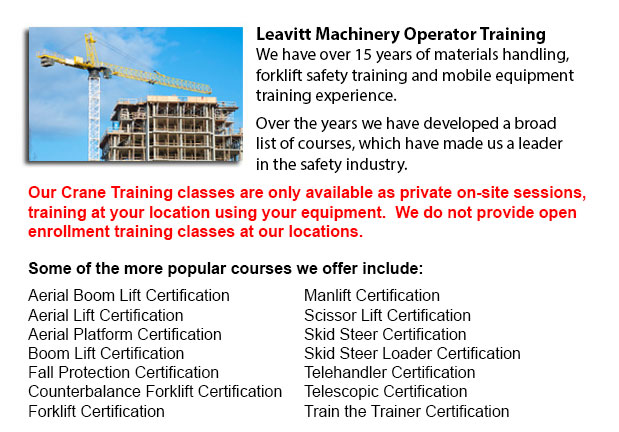
Toronto Overhead Crane Safety Training - Overhead crane safety training equips operators with skills and knowledge about crane safety precautions, accident avoidance, materials handling, and machinery and stock protection. Trainees would learn the types of overhead cranes, their capabilities and their uses in different industry settings. For operators who are licensed and trained, the shift in liability moves to the operator from the company. Hence, the program emphasizes individual operator tasks.
Overhead crane safety training instructs operators in the correct techniques for carrying out inspections. Two types of pre-shift check are the in-depth inspection and the walk-around inspection. These are important daily routines which should be logged. Correctly recorded pre-shift checks help to protect the company from liability in case of an accident. Pre-shift checks likewise prevent costly repairs, accidents and damage. Operators learn how to designate a particular individual to handle inspections, how to report problems, and how to maintain the log book.
Checks must be performed often and documented right. The following must inspected while watching for usual problems: increase in the throat opening, hooks for cracks, degree of twist; hoist ropes for corrosion, worn wires, loss of diameter, broken wires, bird caging and kinks, chains for gouges and nicks, heat and chemical damage, corrosion and cracks, twists, distortion, excessive wear, stretching, pits, damage from extreme heat.
Operators learn correct rigging measures in this course. Rigging includes understanding the manufacturer's data plate, determining the material weight to be lifted, choosing the gear, and utilizing safe practices to secure the load. The course include in detail the following: safe working loads, and the capacities of ropes, chains, hooks, shackles and slings.
It is important to know who can utilize the cranes at your facility, the job's physical requirements, and operator qualifications needed for permits and specialized job. Safety must be prioritized when utilizing near pedestrian traffic.
Safe crane utilization involves responsibilities such as undertaking visual inspections, checking for hydraulic leaks, checking the safety guards, testing the controls, examining the hoist rope and hook, braking mechanisms and limit switches. Right reporting procedures are vital. These subject matters are all included in depth in the program.
Right lifting and moving procedures with cranes and hoists are included in the course. Operators will become knowledgeable in hand signals. Training involves how to raise the load, attach the load, unhook the slings, abort a lift and set the load.
The steps involved with moving the load, consists of: starting and stopping procedures, controlling and guiding the load, observing working conditions and working with signals. In case of power failures, the operator will have to know how to proceed. The course covers methods for lowering the load and removing the slings, storage of equipment, parking the crane, and securing an outdoor and indoor crane.
-
Toronto Wheel Loader Training
Toronto Wheel Loader Training - Normally, the different kinds of heavy equipment training are classed into 2 categories of machinery: those that have rubber tires and tracked vehicles. Tracked vehicles consist of items like for example excavators, cr... More -
Toronto Heavy Equipment Operator Training
Toronto Heavy Equipment Operator Training - Heavy equipment operator training facilities that provide good standards in the business, providing field performance tasks and added machinery training are really sought after training features. Students a... More -
Toronto Manlift Operator Certification
Toronto Manlift Operator Certification - We provide an aerial lift and scissor platform certification and training to empower the trainee with the general understanding and knowledge of the safe and efficient use of "Power Operated Mobile Work Platfo... More -
Toronto Aerial Boom Lift Ticket
Toronto Aerial Boom Lift Ticket - Aerial lifts can be utilized to accomplish a lot of unique duties done in hard to reach aerial spaces. Some of the odd jobs associated with this type of jack include performing regular preservation on structures with... More -
Toronto Heavy Equipment License
Toronto Heavy Equipment License - Obtaining a heavy equipment license is mandatory in order to operate these big industrial machinery. Certification could be acquired through a vocational school or private training. The license would enable the drive... More -
Skid Steer Loader Training in Toronto
A skid-steer loader is an engine powered equipment which consists of a small and rigid frame. It is outfitted together with lift arms that are utilized to connect to a large variety of labor saving tools and attachments. Typically, skid-steer loaders... More -
Toronto Aerial Lift Certification
Toronto Aerial Lift Certification - Aerial Lift Certification is for individuals who requires an in-depth understanding of aerial lift safety. Inspectors and operators, supervisors, maintenance workers and construction craftsmen should perform a cert... More -
Toronto Boom Lift Training
Toronto Boom Lift Training - Elevated work platforms, also called aerial platforms, allow workers to carry out tasks at heights which would otherwise be not reachable. There are different kinds of lifts intended for various site conditions and applic... More

Forklift Certification Toronto
TOLL FREE: 1-888-254-6157
Toronto, Ontario
forkliftcertificationtoronto.com
Email Us
About Us


